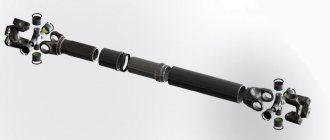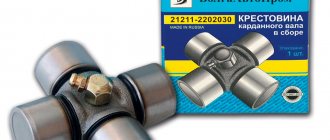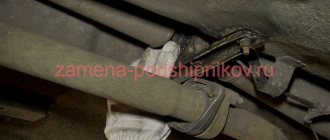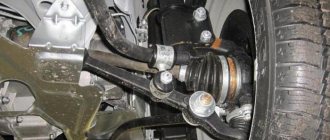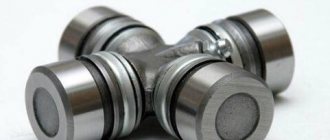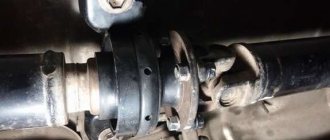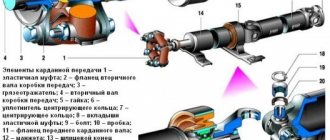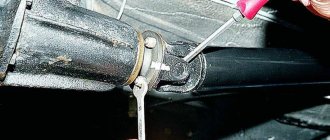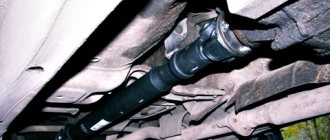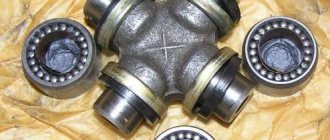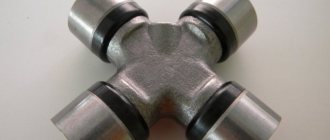1200 rub. for the photo report
We pay for photo reports on car repairs. Earnings from 10,000 rubles/month.
Write:
Balancing the driveshaft can be done either with your own hands or at a service station. In the first case, this requires the use of special tools and materials - weights and clamps. However, it is better to entrust the balancing of the “cardan” to the service station workers, since it is impossible to accurately calculate the mass of the balancer and its installation location manually. There are several “folk” balancing methods, which we will discuss later.
Signs and causes of imbalance
The main sign of an unbalanced driveshaft of a car is the appearance of vibration in the entire body of the car. Moreover, it increases as the speed increases, and depending on the degree of imbalance, it can appear both at a speed of 60-70 km/h and at more than 100 kilometers per hour. This is a consequence of the fact that when the shaft rotates, its center of gravity shifts, and the resulting centrifugal force “throws” the car on the road. An additional sign, in addition to vibration, is the appearance of a characteristic hum emanating from under the bottom of the car.
Neglecting a breakdown can lead to such consequences
There are several reasons for this breakdown. Among them:
- natural wear of the part during long-term use;
- mechanical deformations caused by impacts or excessive loads;
- manufacturing defects;
- large gaps between the individual elements of the shaft (if it is not solid).
Regardless of the reasons, if the symptoms described above appear, it is necessary to check for imbalance. Repair work can also be done in your own garage.
How to balance a cardan at home
We will describe the process of balancing the driveshaft with your own hands using the well-known “old-fashioned” method. It is simple, but it can take quite a lot of time . You will definitely need an inspection hole into which you must first drive the car. You will also need several weights of different weights used when balancing the wheels. Alternatively, instead of weights, you can use welding electrodes cut into pieces.
A primitive weight for balancing a cardan at home
The work algorithm will be like this:
- The length of the driveshaft is conventionally divided into 4 equal parts in the transverse plane (there may be more parts, it all depends on the amplitude of vibrations and the desire of the car owner to spend a lot of effort and time on it).
- The above-mentioned weight is attached securely, but with the possibility of further dismantling, to the surface of the first part of the propeller shaft. To do this, you can use a metal clamp, plastic tie, tape or other similar device. Instead of a weight, you can use electrodes, several of which can be placed under the clamp at once. As the mass decreases, their number is reduced (or vice versa, as the weight increases, they are added).
- Next is testing. To do this, drive the car onto a flat road and analyze whether the vibration has decreased.
- If nothing has changed, you need to return to the garage and transfer the load to the next section of the driveshaft. Then repeat testing.
Mounting the weight on the cardan
Items 2, 3 and 4 from the list above must be performed until you find an area on the driveshaft where the weight reduces vibration. Next, in a similar experimental way, it is necessary to determine the mass of the weight. Ideally, if it is selected correctly, vibration should disappear completely.
The final balancing of the “cardan” with your own hands consists of rigidly fixing the selected weight. For this it is advisable to use electric welding. If you don’t have one, then as a last resort you can use a popular tool called “cold welding”, or tighten it well with a metal clamp (for example, a plumber’s clamp).
Balancing the driveshaft at home
There is another, albeit less effective, diagnostic method. In accordance with it, it is necessary to remove the driveshaft from the car. After this, you need to find or select a flat surface (preferably perfectly horizontal). Two steel angles or channels (their size is unimportant) are placed on it at a distance slightly less than the length of the driveshaft.
After this, the “cardan” itself is placed on them. If it is bent or deformed, then its center of gravity is shifted. Accordingly, in this case it will scroll and become such that its heavier part is at the bottom. This will be a clear indication to the car owner in which plane to look for imbalance. Further actions are similar to the previous method. That is, weights are attached to the cardan shaft and their attachment points and mass are experimentally calculated. Naturally, the weights are attached on the opposite side from the one where the center of gravity of the shaft is shifted.
Balancing cardan shafts: all the nuances and repair possibilities
What is it - balancing cardan shafts with your own hands, and “what do you eat it with,” as they say? Probably, few of the average car enthusiasts have seriously faced this issue for real. Although for owners of used cars with a driveshaft, one way or another, problems with vibration or an unpleasant hum in this area sometimes come to light.
For those who do not yet attach the necessary importance to the transmission parts (well, it hums and vibrates - so what): an experienced mechanic will probably tell you what the dangers of such an imbalance of the cardan are. And this problem, which seems not so important to many, can lead to disastrous consequences: rapid wear of the transmission in particular, and the entire car as a whole.
In addition, such problems cause greater fatigue and loss of concentration during prolonged driving. And all these reasons can ultimately lead to accidents on the roads.
Balancing driveshafts with your own hands can be comparable to balancing wheels. In practice, driving a car with unbalanced tires is possible (and many careless drivers take advantage of this). But the problems and material costs associated with this, believe me, are not worth it. It’s better to hang the weights on time. And most likely, do a complete wheel alignment of your chassis.
So that when driving you don’t feel pulled sideways and you don’t feel the wheels beating when you pick up speed. Of course, an important place is also occupied by the issue of a comfortable ride, from which you enjoy, and do not swear after each “difficult” kilometer. In addition, in the end, with such a long enough ride, worn out and beaten tires have to be changed. And this can cost a lot.
Causes and symptoms
Let's get back to our cardans! There can be many reasons for the malfunction and imbalance of these devices. The most basic: wear and tear during long-term use, manufacturing defects, mechanical deformations caused by impacts. Another reason is that the gaps between the elements of which it consists are too large.
If, for example, you repaired a cardan or installed a new one. There is also a need to perform balancing when installing a used shaft.
What are the signs that the driveshaft is out of balance? The main thing is to increase the level of vibration when the car is moving until it is clearly felt by the driver and passengers. Additionally, a clearly audible hum may appear, accompanying the vibration of the housing.
Folk method
As soon as you begin to feel vibrations that seem too strong and unnecessary, and getting to a service station is not possible - due to time or money - you can balance the cardan with your own hands. Fortunately, folk craftsmen have long developed a rather labor-intensive but effective method.
DETAILS: Changing engine oil Volkswagen Passat b5 and b6
No matter what experienced garage technicians tell you, full balancing of the driveshaft is only possible with special equipment. Another matter is the elimination of imbalance caused by improper assembly of the cardan or malfunctions of the crosspieces and the elastic coupling of the cardan transmission. Such repairs can be done with your own hands in a regular garage with an inspection hole or overpass.
For repairs, restore the alignment of the hinges.
Cardan imbalance is a very alarming signal. This problem can only be fixed professionally at a service station. But if for some reason you do not have the opportunity to seek help from a specialist, then this article is for you, because balancing driveshafts is an integral part of a high-quality and comfortable ride.
Cardan shaft
Every experienced motorist knows that vibration of the cardan leads to rapid wear of the entire car, and in particular to wear of the cardan drive. In addition, this problem causes enormous discomfort when driving, which even affects the driver’s well-being. Only balancing the cardan shafts will help eliminate this problem.
Technological repair method
Cardan balancing machine
But if 5 thousand rubles is not a pity for such a task, this is exactly the price of balancing the shaft in a workshop, then we recommend going to specialists. Carrying out diagnostics in repair shops involves using a special stand for dynamic balancing. To do this, the driveshaft is removed from the machine and installed on it. The device includes several sensors and so-called control surfaces. If the shaft is unbalanced, then when rotating it will touch the mentioned elements with its surface. This is how geometry and its curvatures are analyzed. All information is displayed on the monitor.
Repair work can be carried out using various methods:
- Installation of balancer plates directly on the surface of the propeller shaft. At the same time, their mass and installation location are accurately calculated by a computer program. And they are attached using factory welding.
- Balancing the driveshaft on a lathe. This method is used in case of significant damage to the element geometry. Indeed, in this case, it is often necessary to remove a certain layer of metal, which inevitably leads to a decrease in the strength of the shaft and an increase in the load on it in normal operating modes.
The secret to proper assembly
Professionals know that there are only two positions in which a driveshaft can be assembled, and here's why:
- The universal joints must operate in the same symmetry to ensure equal angular velocity;
- According to the standards of manufacturers, the flange-forks must be in the same plane, this equally applies to welded forks into the pipe.
Now it’s easy to guess that compliance with these conditions is possible only in two positions. Assemble the driveshaft, observing these conditions - if the vibration does not disappear, turn the driveshaft in the splines 180 degrees.
Regarding the installation of a driveshaft on a car. The location of the receiving flanges on the bridge, box or transfer case does not matter. The main thing is a good fit of the propeller shaft flange to the receiving flanges on the car.
This process can take a lot of time and effort. To avoid this, you can contact KardanValService-Sever and have the driveshaft balanced.
Causes of imbalance
The following can contribute to shaft malfunction:
- natural wear of the part during long-term continuous use;
- failure to comply with technical regulations for the use and maintenance of the machine;
- manufacturing defects;
- mechanical damage that occurs when interacting with a solid object, etc.
A sign that an unbalanced condition of the shaft has arisen is an increase in the level of vibration of the cardan when driving to the point of discomfort for the driver and passenger in the car.
How to do balancing yourself?
Below is an old but effective method for restoring a driveshaft. Its disadvantage is that it is time consuming. To carry out the manipulation, you will need a convenient inspection hole or overpass, weights with different weights. The latter can be replaced with pieces of welding electrodes.
Work is carried out according to the instructions:
- Conventionally divide the pipe crosswise into 4 identical sections. The number of parts can be increased depending on the strength of the shaking and the large amount of free time.
- On the first piece of the cardan you need to attach a lead weight with an approximate weight of 30g. so that it is securely fixed to the surface with the ability to easily remove it. Typically, to ensure such fastening, a metal clamp, strong adhesive tape (duct tape or tape), a soft tie, wire, etc. are used. If electrodes are attached instead of a load, then attach more than two pieces at a time. Their number varies as the total mass decreases.
- Take a test. To do this, you need to drive out onto a smooth road and check the degree of vibration. If it becomes less noticeable, then the correct section of the cardan has been selected for balancing.
- If the level of car vibration remains at the same level, you should fix the weight on the next part of the shaft, marked at the beginning of the procedure.
It is necessary to repeat these stages of work until that section of the cardan is found at which vibration manifests itself to a minimum extent. Next, you need to select the optimal weight of the weight, at which the shaking disappears completely. This is an ideal option, however, when balancing yourself, you can allow residual, slightly perceptible vibration of the machine.
The final stage of balancing the shaft using this method is the rigid, durable attachment of the load to the cardan. The best attachment option is to use electric welding. If this is not possible, then the “cold welding” substance will be an alternative. An undesirable, but often used method is to securely tighten the weight with a metal clamp.
Other shaft balancing techniques
- Another method begins with removing the driveshaft. It is placed on a perfectly flat horizontal surface on low metal stands. The distance between them should be slightly less than the length of the shaft. A deformed cardan has a displaced center of gravity. In this position, the part will rotate, and its weighted section will be at the bottom. This method can become a “preface” to the already described algorithm. Thanks to it, identifying the required section of pipe will be faster. However, finding a perfectly flat plane for its application is not always possible.
- Using a frequency analyzer. You can assemble it yourself, but to monitor the operation of the device you need to install a special program on your computer. The results of vibrations on each pipe section are recorded, and the location of the imbalance is calculated. This method helps to cope with vibration for a long time, but does not eliminate it completely.
Do you really want to forget about shaking in the car and save your time? Order the cardan balancing service at an affordable price.
Temporary elimination of imbalance
The vibration that arises along the way cannot be ignored, so at the first sign you should go to a stand for balancing driveshafts. Being outside the city, it is not always possible to get to a service station with the necessary equipment. In this case, you should perform balancing yourself. The following sequence should be followed:
- Place the car on an overpass or over a hole in the garage, as you will need access to the driveshaft.
- Divide the cardan in half lengthwise.
- Conditionally divide the cardan crosswise into 4 parts. If the car owner has a lot of time, the cardan can be divided into 8 or even 16 parts.
- Take a weight with a weight of up to 30 grams. A piece of lead or a wheel balancer is suitable for these purposes.
- Number the parts of the cardan and attach a weight to the first section.
- Drive onto a flat section of the road and listen to the vibrations.
- Consistently test the car, changing the position of the weight. In this case, it is necessary to find a position in which vibration is minimized.
- By changing the weight of the weight, you need to ensure that there is no vibration in the car interior. At the same time, visual elimination of interior rattling does not mean the complete elimination of parasitic loads on the cardan. At the first opportunity, you need to balance the cardan using special equipment; you need to visit a service station.
- Secure the weight using welding or glue.
By balancing the shaft, the car owner will protect the car from serious repairs. Traffic safety will also increase, since the vibration transmitted into the cabin significantly distracts and irritates the driver.
Terminology
- Imbalance is the discrepancy between the axis of rotation of a body and its main axis of inertia. Such imbalance of the rotating elements of cardan shafts or other rotors leads to vibration. The latter will be the cause of fatigue cracks in the cardan fastenings, which quickly develop into ruptures. Threaded connections exposed to vibration gradually weaken and unwind. This can lead to an emergency due to the cardan falling while the vehicle is moving. Moreover, vibration has a negative impact on the driver: it contributes to rapid fatigue and distracts him from assessing the road situation, which also increases the risk of an accident.
- The main axis of inertia of a shaft is called the axis of symmetry, passing through its center of mass.
- Balancing cardan shafts is the process of eliminating their imbalances, which consists of moving the main axis of inertia until it aligns with the axis of rotation.
If you have not yet managed to disassemble the cardan
Kardan Val Service North LLC Article
Assembling a driveshaft is an operation that requires a responsible approach.
If you are just planning to disassemble the driveshaft, be sure to mark all components using a marker or core. If you are going to change the crosspiece, you need to mark how the flange is positioned relative to the welded fork in the pipe. When replacing the bearing, place marks on the kit under the support. The same applies to other nodes!
Preliminary marking is the basis in any business. This simple operation will save you from subsequent problems with reassembly.
There are cases when the driveshaft inadvertently splits in the splines during dismantling. Or, due to inexperience, the car enthusiast did not put marks in advance when replacing the crosspiece or outboard bearing.
Take a close look; on some European-made driveshafts, marks are placed at the factory in the form of convex triangles, arrows and dots; sometimes curved balancing plates and even grease nipples act as marks.
Note: there are marks on all cardan shafts with offset crosspieces relative to each other.
If you do not find marks, you have two options - contact a specialist to balance the driveshaft or try to find the correct position yourself.
Types of balancing
- Static. It is used to determine and eliminate rotor imbalance without taking into account the forces arising during rotation. To statically balance the rotor, you need to shift its center of gravity so that the axis of rotation passes through it. Used for disc-shaped rotors with a length-to-diameter ratio of no more than 1/4. This balancing is carried out in one correction plane and is not suitable for cardan drives.
- Instant. To perform this balancing, the main moment of shaft imbalance is determined and reduced, which is an indicator of the moment imbalance of this rotor. This operation is performed in at least two correction planes.
- Dynamic. Includes static and instant. Used for long rotors. Best suited for balancing driveshafts. Therefore, balancing the cardan is done on equipment that uses this method.
When observing the balancing process on a bench, it is impossible to understand which method is being used. The operation of all stands looks the same - the shaft rotates, and the display shows the location and magnitude of the imbalance.
Disassembly and assembly of the cardan
To avoid the need to balance the driveshaft after repairing it yourself, you need to mark the position of the shafts of which it consists relative to each other. And when assembling the cardan, be sure to match the marked marks. You can see how to do this in the video. If you forgot to mark the position of the universal joint components before disassembling, another video will help eliminate the resulting vibration.
When is cardan balancing necessary?
- When modifying the driveshaft (shortening, lengthening, etc.).
- After eliminating significant deformation of the cardan, which is a consequence of, for example, a strong impact.
When is cardan balancing carried out?
This element is balanced in the following cases:
- identification of manufacturing defects of this part during the operation of the vehicle. This happens infrequently, but no manufacturer is immune from even a small number of defects. So, for example, the BMW company has a share of officially recorded defects of 0.5%, while VAZ has this figure twice as high;
- when replacing the driveshaft due to its breakdown;
- violation of the technological gaps between the parts of the cardan during its assembly and installation on the car (first, balancing is carried out on a stand, after which the element is disassembled and balancing is carried out on the car);
- If the driveshaft is not installed according to technological requirements, its alignment may be disrupted. In this case, the cardan is removed and sent back to the balancing stand, after which it is reinstalled on the machine;
- The most common reason that the stabilizer begins to touch is mechanical damage on the road. Being under the bottom of the car, a stone can easily get into the cardan and fly away from under the wheel, as a result of which its alignment is disrupted;
- theoretically, an imbalance of this part could be the result of corrosion that has changed the geometry of any component of the cardan, or even simple contamination. However, in this case, the imbalance will not be so large as to significantly affect the quality of this mechanism.
Causes of driveline vibration
- Play in the bearings of the crosspieces exceeds the permissible values. This malfunction, as well as the next one on the list, is eliminated by replacing the cross that has become unusable.
- Loss of mobility of crosspiece needle bearings due to corrosion. You can detect this defect with your own hands if, before repair, you disconnect the fastening of at least one end of the cardan drive from the transmission flanges and try to move the free end to the side.
- Deep cracks in the elastic coupling. Repair consists of replacing this part.
- Misalignment of the crosspieces after alteration of the driveshaft or due to incorrect assembly of the unit with two crosspieces at the edges and a splined connection between them. For repairs, restore the alignment of the hinges.
- Loosening of the flanges of the cardan and the axle gearbox.
- Unscrewing the nut securing the flange to the gearbox shank.
- Suspension bearing failure.
- Excessive spline play.
- Deformation of the cardan transmission pipe.
Vibration of any car unit easily spreads throughout the body, which is why it is very difficult to correctly determine its source. Therefore, if you detect a hum and vibration of the floor in the car while driving, do not rush to blame the cardan transmission for this, but start repairs by inspecting the engine mounts, gearbox and their fastenings.
